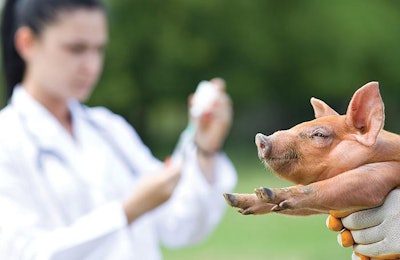
Porcine circovirus (PCV) is so called due to the circular form of its DNA. PCV type 2 is the causative agent of several diseases including porcine multisystemic wasting disease (PMWS) in piglets and PCV-reproductive disease (PCV2-RD) in sows. The virus is transmitted through infected feces and via mechanical means including clothing, equipment and vehicles. It is thought that rodents and birds may also be able to spread the virus. Mixing of pigs, stressful conditions, continual production and high stocking densities make the occurrence of clinical signs more likely.
The virus attacks the immune system of pigs; white blood cells are depleted, and lymph nodes are enlarged. Following post-mortem examination, lesions can be seen in multiple organs including the lungs, tonsils, spleen, liver and kidneys. Diagnosis of circovirus is based on the presence of these lesions, along with laboratory identification of the virus within tissues.
The virus is often associated with other pathogens such as influenza virus, PRRS virus, porcine parvovirus, Lawsonia and mycoplasma. It is in these cases that it causes significant health effects. These concurrent conditions become more severe, last longer and do not respond to treatment as expected. One veterinarian described it as the ultimate camouflaging agent; you can treat the other diseases, but until you address circovirus, the pigs won’t get better. Normally, cases of influenza that would last one or two weeks last three to four weeks in the presence of circovirus, with new cases still occurring. It is thought that the fact that the virus damages the immune system of pigs means that it leaves animals immune-suppressed.
Prevalence of circovirus
The virus was first identified in 1985, and the clinical disease was first described in Canada in 1991. It is widespread in North America, Europe and Asia. In the U.S., clinical disease started to be seen between 2004 and 2006 and is now believed to have infected virtually every herd in the country. There were disease conditions on farms where the pigs stopped responding to antibiotics or didn’t recover as well as expected. Over the next two years, the disease situation escalated and even high-health status herds were suffering.

Due to improved sequencing techniques, a large number of PVC2d strains have been circulating in the global pig herd for at least 17 years.
However, even if herds are PCV2-positive, relatively few will develop clinical signs of PVC2 associated disease. It seems other triggers are required: related to environment, health status and management. Even in herds with a history of PMWS not all groups of pigs will show clinical signs.
Symptoms in pigs
PMWS in piglets is most commonly seen between six and eight weeks post weaning but can affect them as early as two to three weeks after weaning. They lose weight and gradually become emaciated. Their skin is pale, sometimes jaundiced, and the coat is rough. Piglets may suffer from diarrhea and respiratory distress. If the pigs made it to 10 to 12 weeks, then they survived, and no new cases were seen. However, in certain complicated disease conditions, it could last longer. Clinical cases can keep occurring in a herd over several months, reaching a peak after 6 to 12 months, followed by a gradual decline.
Even in the least severely-affected herds mortality could increase by three to four times and morbidity by 6 to 8 percent. “When the virus was present alongside other diseases, mortality could reach 30 to 40 percent,” he explained. “But under sub-clinical conditions, the virus is a drag on the pigs, significantly affecting growth.” The economic importance of sub-clinical infections is often underestimated. While in cases of high mortality, cost in loss of animals is obvious. The virus is known to not only retard growth but also affect feed efficiency and uniformity. The additional expense of antibiotic treatments, etc. should also be accounted for. “For example, if the infection is co-current with Lawsonia — diarrhea is more severe and unresponsive to treatment.”
PCV2-RD is characterized by longer return-to-estrus periods, abortions, still- or weak-born piglets. “We have seen these symptoms in new or recently expanded sow herds,” stated Dr. Bernd Grosse Liesner, global technical manager, swine vaccines, at Boehringer Ingelheim Animal Health. “In many cases, gilts seem to be susceptible to PCV2-RD, even if they were vaccinated as a piglet. PCV2 infection should be considered when diagnosing reproductive disease in sows, if breeding performance is lower than expected.”
An evolving disease
Variants of the PCV2 virus have been found in pig herds around the world, and studies indicate constant genetic variation. “So far, 5 different subtypes have been described for PCV2 (a, b, c, d and e),” explained Dr. Grosse Liesner. “They have all been present in the swine population for much longer than PCV2 vaccines have been on the market. They have, therefore, faced these subtypes for many years, and the vaccines continue to demonstrate efficacy against them.”
The reported discovery of different PCV2 subtypes has led to debate on vaccine efficacy. “It is only recently that cost reduction has allowed more routine use of sequencing of viral DNA,” he proposed. So when new strains are isolated, it may in fact be that, although they have only been recently described, they have already been present in the pig population for a long time.

















